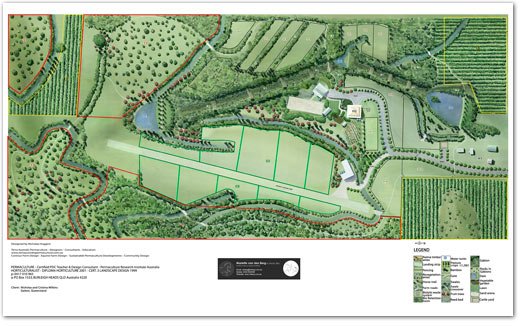
Click for larger view on PRI website.
Introduction
I want to share with you a few things about a permaculture design project I finished in late October 2010. Details of the design, some details of working with clients on design projects, basic costing and what to be aware of when doing so. I also outline how I put the project together and what it included.
Equine (Horse) Industry
By chance, I have just thrown myself into a permaculture niche that was waiting to be filled. My partner Mariette van den Berg (see past post on PRI), of Dutch decent and now living in Australia with me, has always had a love for horses — studying at university in The Netherlands and also New Zealand where she finished her Masters Degree in Equine Nutrition. Mariette now finds herself questioning her years of study and looking to Permaculture for ways of increasing equine health through design.
Ever since I dived head first into permaculture design and consulting, Mariette and I have found our professions coming together to look at how designing horse properties can save our land from the poor management of people (horse owners) I’m going to call ‘city farmers’. City farmers are, in my opinion, high disposable-income earners seeking the tree change, buying the big flashy property but generally without a single idea on what it takes to care for the land — and most of all they realise it’s going to cost them a lot of money depending on their method of management. There are many animal welfare issues that I see on a regular basis that I’m having trouble coming to terms with. I doesn’t take much to look over a fence and see how people treat their pastures, and a direct reflection of this is the health of their horses and how often the vet visits.
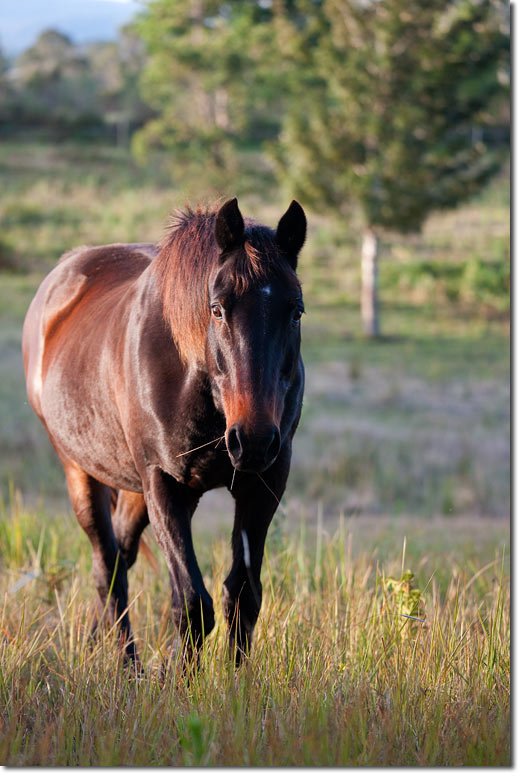
Photo© Craig Mackintosh
Question: Why does anybody keep horses? There are as many reasons as there are horse owners. For some people, it’s the joy of saddling up and riding for hours anytime they want to. For others, it is the love of the animal, of having such a smart and personable creatures as they are. Still others take great joy in the sight of their own horses grazing in the pasture, and for others it is the joy of foals every spring.
Some people see horses as work tools; still others see them as pets. We have taken the horse from a means of transport, a beast of burden, to something that people can indulge in their leisure time. Whatever the reason, from what I can tell, those with horses derive a great deal of pleasure from having them. Some owners consider them as pets, partners, or friends. This was a quote from a social networking site about keeping horses: “We can work with them and feel social without the drawbacks of having another human around”. I think that goes for many people that own a pet. So much focus, attention and money is given to the pursuit of owning horses, and, from what I have seen, from consulting to horse owners, very little time or attention is given to the health of Gaia (the Earth) on which they so depend.
Another thing that I’m acutely aware of, being the partner of a horse enthusiast, is the amount of money is drained into the romance of keeping horses. While at this stage Mariette doesn’t have any horses of her own, she has in the past. It got me thinking when this project came up. Does anyone who owns horses, whether for breeding, racing or leisure, have a system by where they can close the loop on the input cycle of keeping horses?
There is something about horses that make savvy business people forget what they learned in Business 101. The dream of breeding the perfect yearling and owning a lavish equine farm often dulls the sharp business judgment that earned them the money to get into the horse business in the first place.
Writing for Horses & People Magazine
The second niche I have fallen into is writing for an Australian national magazine called Horses & People. If you’re serious about getting your name out there, then this is something every permaculturalist should get looking at getting involved in. Writing for a magazine, paper, and website is something that can only improve your knowledge and in my case, improve my writing skills.
As it happens, this design project is being put together for the editor/director of the horse magazine. And for future stories we will use stages of the implementation as case study stories, following the progress of its evolution through the coming years.
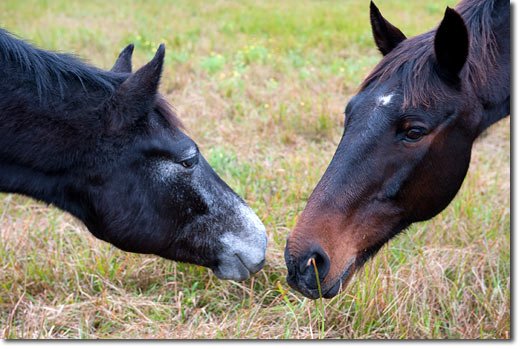
Photo© Craig Mackintosh
Getting the Job
All my permaculture design work/consultations are coming from many and varied sources: clients calling me for my services from seeing my work in equine magazines, from writing posts on the PRI website (with the posts linking my services to an established business like www.globallandrepair.com.au in Canberra), and most of all, business networking clubs. I swear by business networking, and there is bound to be one in your local area. They’re usually full of good salt of the earth small business owners (not managers) from all walks of life.
I started going to networking when I was 19 years old and I never looked back. The links to business mentors who have been through the process of starting a business, marketing themselves, etc., provide priceless information, and from it you’ll build quality relationships and trust. The sorts of business owners that go to these are, accountants, book keepers, sign writers, business coaches, web consultants, motor mechanics and the list goes on. And I found out very quickly, that over the years these types of businesses are paramount in getting your business up and running, and with relationships comes free advice — sometimes!
Getting the Call
So, you get a call from a prospective client. You know how friends may have said in the past that when they go for a job interview with a company, that it’s the worst thing in the world. They get so nervous and hate every minute of it. Well in the world of consulting and design every call is your interview. From that call the potential client considers how you come across and if you’re the best person for the job.
Ok, so let’s take another look at it. Turn the tables and put together a list of questions that will help you work out if this potential client is someone you want to work with. Find out whether they understand what your business is about and what they think their level of involvement will be. There is no use getting the job, spending thousands of their dollars designing this dynamic abundant system if they don’t understand what’s involved with managing it. And before you get off the phone, make sure they understand the costs associated with you consulting on their site: time, travel, accommodation.
For those costs, set up a list of fees. For example, travel costs. I charge $0.81 p/km to the site and return. Believe me that’s expensive. Also, one thing I do is spend two hours of office time researching their property on Google maps, looking at land relief, climate data and what can grow there. This also forms a part of the consultation time. For consultations, I work on a day (6 hours) or half (3 hours) day rate (depending on the distance from home). I find if you work on an hourly rate then the client is likely to want to get you in and out as fast as possible. If you are going to provide a detailed, professional service then you need time on your side. And a set day rate lets you relax, observe and take it all in. I get the client to provide lunch for me so we can relax and get down to some serious design brief extraction.
Administration
Be sharp with your record taking. Get full names of the clients involved and the specific addresses of the site. I know from experience what appears on Google maps is not always correct in rural Australia. Get the client to give you directions from a main road with land marks to help you get there quicker.
Use email to follow up calls and confirm points discussed. Sending accounts for deposits before a consultation gets underway is always a good place to start to see if a client is fully committed. Using their money for travel expenses rather than your own. If they balk at paying a deposit then don’t go…. Talk it through with them and find out why?
I know most people reading this will never do this but I’m just drawing an analogy. When you go to McDonalds you pay for your meal before you get it, right? So why should a permaculture consultancy be any different. McDonalds are a cash flow positive business. But they buy their food on 30+ day accounts, pay their maintenance contractors on 30+ day accounts and keep everyone else strung out waiting for money. I’ve been there before. My Landscape company serviced 95% of the stores on the Gold Coast in Queensland for 10 years, and always ran into this problem all the time. I’ll never do that again!
Don’t fall into that cycle. Keeping your permaculture design business cash flow positive is something everyone should set as one of their business goals (make it company policy) and be very up front about it. This will allow you to pay people you rely on and then the flow-on effect of up front payments will keep it rolling. Remember the People Care ethic. This is an energy transfer, what ever energy you transfer, keep it positive.
Consultation
Client Relationship
Communication: The key to any success in business is communication. Always keeping the client in contact, via email, phone, or in person. Clients want to know how things are progressing with their project, and at what stage you’re up to.
It’s not so much a trust thing; I have found with most clients it’s inclusion in the project and they want to feel a part of the evolution of their land. You shouldn’t be afraid to also tell them in advance if you hit any problems that will affect the project, or its due date, like if one of the consultants is sick for example and that will put you back a few days. But don’t get too detailed, or their confidence in your ability to manage the project may creep into their mind.
Also, if you have a few consultants working on site, make yourself available to be there to take care of things like questions they may have. Book them ahead to be there on a day that suits you, so your time is not wasted.
I feel it’s about being professional and having that approachability — bridging the communication streams, client vs. sub-contractors vs. you. There is nothing wrong with interaction, but when there’s miss communication and you’re in the middle, it can get confusing for all involved.
Deliverables: designers and architects work on the basis of deliverables. Consider what your deliverables are through the project and at what point you will deliver those. Concept, site visits, master plan, plan documentation and even invoicing for getting paid need to be noted in your contract. This way the client is aware, for example, that when the concept is produced then they are responsible paying a dollar value or percentage of the contract to you for work delivered. Again, it’s all about communication, in this case, the written form.
Contracts
This is something I have spent a lot of time & money on over the years and am now adapting for my permaculture work. Contracts are communications to the client from you detailing what you will supply them. Whether it’s services or goods, it needs to be detailed and communicated what they will receive for their money. Under promise and over deliver, it’s an oldie but a good style to have. Keep the scope of the project in mind when pricing the project. When’s the money coming in? When do I need to pay the other consultants? What’s their terms of trade? COD (cash on delivery), 7-14, 30 days and how will that effect you? I have some very simple contracts that I have developed, if you would like one, they’re in MS Word format. Send me an email and I’ll send it to you to play with and set into your own style.
Design
Site & Climate Analysis: The location of this particular project is situated just outside one of Australia’s largest food growing areas — Lockyer Valley, Gatton, Queensland. It’s known for its deep soils and capacity to produce food. It’s in a very stable climate with regular rainfall and a supply of ground water. But that’s a whole post in itself, on the damage this mass-produced Agriculture is doing to the valley and its people.
The site for this design was very interesting. Mount Sylvia is where this project is located, 25km south of Gatton. It’s interesting because in my research on the local climatic conditions before starting the design I found that
(extract taken from my design report):
Climate Zones: Based on BOM maps, the Lockyer Valley falls into an interesting climatic zone. It borders 4 classic climates and this is interesting in its own right in regards to the adaptability of plants and styles of farming.
Standard 30 year climatology information shows that the orthographical effects of the great dividing range at Toowoomba to the west, the blocking effects of the Border Ranges National Park to the south, the unnatural heat sink of the Ipswich to Brisbane growth corridor is having an effect of increasing updraft of cool sea air and not letting that air flow through to the Toowoomba escarpment and allowing the orthographical nature of the range control the climate.
Looking at the seasonal variation of other regions that border the Mt Sylvia property gives a good indication of the cycles of weather. This is always a handy tool when preparing planning for such a project.
Definition of this site is ‘hot humid summers’. Within 50km to the east of the site the zone from Ipswich to the Brisbane bay consists of a ‘warm summers, cool winters’ or a ‘temperate to subtropical’ climate. The effect of the Toowoomba range, has a cooling effect in winter with strong westerly winds pushing the warm ocean thermal mass back to the ocean edge. Toowoomba’s climate is consistent with a ‘temperate to cool climate’ with ‘hot dry summers and cold winter’.
So as you can see, when investigating the site you’re working on, it pays to be very thorough and talk with local farmers who have lived there for generations and have the knowledge and also government weather information.
Presentation and Documentation
Style: I went with a very easy to read A3, full colour format for the documentation for the report — wire bound with clear cover page and hard card backing. It gives the client very easy to find and read content. This option is not cheap but not the most expensive either. I produced three copies; one for myself and two for the client. One was for indoor use and the other was more robust in that it would be used for construction and so came with a weather-proof folder for safe keeping.
Content: The A3 full colour documentation folder itself was 74 pages. Also included were six other books: three A3 folders that included all Queensland government information on native and non-native species and flora and fauna specific to the bio-region, three other A4 books on systems related to the construction of their new house, regulations on the construction of new dams and the harvesting of surface water and a host of other topics.
Time to Produce: The overall full time total from start to finish, including site visits and waiting for government agencies to call me back, was a total of four weeks full time, 5 days a week — so 160 man hours. Final cost to the client was a bit over $10,000. This works out to about $135 per page. That’s not that expensive for what’s possible for the end result of the project having both equine and human systems provided for in a 90% closed loop system. Try to put a price on that!
Initially it’s going to be hard to quantify yourself on time taken to do this sort of work. It’s going to be trial and maybe lots or error on hours at first, but as time goes on you’ll know what it’s going to take.
Reverse engineer everything you do when breaking down a permaculture design project. What do you want the end result to be? A glossy 74-page full colour, bound presentation with hand drawn concept plans by a graphic artist, or, something very simple — an A1 style plan, hand drawn with specifications and documentation. So if it’s the former, you’ll have to take into account costs before starting, and these will need to be included into the quotation price, or you’re going to find out very fast that all that money you were planning to make is going into expenses that you had overlooked.
Outsourced work: The whole design that I put together for the client included a full range of people, brought in for their specific skill set and knowledge. Permaculture is about bringing together people, trades and professional and scientific backgrounds to produce a functioning design. Some of these included: an equine nutrition consultant (she was cheap being my partner), an architect in Peter Brecknock from Allyn River Permaculture, environmental consultants, a graphic artist & CAD draftsperson, a horticultural botanist for plant ID, a tree and timber consultant, a solar & electrical consultant, and a host of other trades with skills in construction and management of the site moving forward from concept to construction.
Make sure before you cost your project that allowances for all these people are built into your quotation — as I mentioned before, for site visits, phone or Skype calls and for them to produce reports that will form the bulk of your project documentation.
The Plan: A good part of my time was spent drawing up the concepts on computer. Layering the topographical maps and moving and playing with all the elements to complete the clients brief. Moving swales and stables to incorporate roads, an aircraft landing strip that had a multi-function role like any good permaculture design. (The Landing strip serves as a runway, cattle cell grazing on the lane and hard water runoff for paddocks.)
Once that was all compiled, I then employed a skilled graphic artist. For this sort of design work (main frame design) I don’t find it necessary to have a scaled, technical drawing. All the concept design work was done off highly detailed professional surveyor’s contour plans and set out on the ground before a final was produced. This sort of work is all about the big picture, the overall function of the design. If you want to design and construct then this design style is not for you. You will need to invest many years and dollars in getting skilled in computer AutoCAD to design in 3D when working on contour. What I mean is, when working on hilly country that straight or curved line on the plan may well say 100m on your scale ruler, but add the slope and contour and it’s all of a sudden 140m — and since you costed that part of the job out for 100m, now your budget is blown.
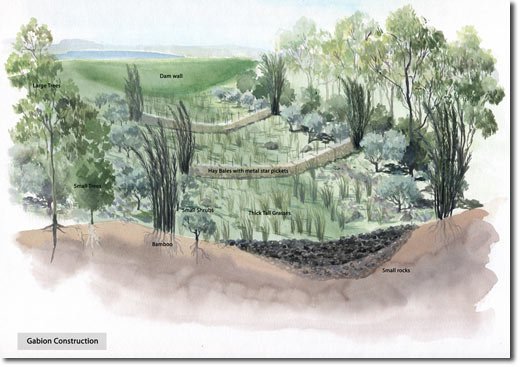
Click for larger view
Something I’m very interested in, is costing and estimation skills and project management for permaculturists. Over my years in landscape construction, I employed three full time estimators to do this sort of work. It’s a real skill and talent to do this sort of work. If you do want to get into putting together budgets for your clients to include in the projects (not a quote but a budget), this will give them a good idea of what your amazing design will cost them and so over time they can plan its implementation.
Conclusion
So what I have tried to do in this post is give you some of the basic aspects of putting together a design, how to work with clients and what are some of the things to look at.
In conclusion, I just wanted to give you some of the details of the project specifics that were designed for inline with the client’s brief.
Client brief, as I interpreted it:
To use permaculture design to create sustainable human & equine habitats that emulate nature’s patterns, cultivates a role for biodiversity, and maintains a function for native species; to use Queensland architecture and sustainable materials to create an ecologically harmonious environmental space; to use renewable, non-polluting, integrated systems and technologies to meet all human & equine needs and enhance the environment; to use the designed environment to suit economic needs while providing for lifestyle, livelihood and physical growth.
I’ve included an extract from the final design (10mb PDF) to give you an idea of style and content. I’m sorry I couldn’t put the whole design up online — even in PDF it’s 97Mb.
In line with the brief, Mariette and I wanted to prove to the equine community that this style of property could be sustainable and regenerative in its application and far superior to those horse studs or farms designed around European aesthetics.
We looked into and investigated alternate feed and forage systems for horses. After the recent floods in Queensland and southeast Australia, People are madly buying up hay for feed because the pasture grasses drowned, with metres of water over it for weeks. There is a real need to look for alternate feed systems so we don’t rely on just one source.
The report covers specific topics important to the farm’s regeneration. An introduction to permaculture was and is very important for the client to understand. So every client, regardless of consultation, gets a Permaculture Designers’ Manual and a DVD of Geoff Lawton’s Introduction to Permaculture Design — the first as a reference and the DVD as an intro into permaculture, so that the client has a basic understanding of pattern and the elements within the design and how they will function.
Zone & sector analysis is some of the most important information, and that will form the basis of the concept plan.
First you give a concept brief, then continue into the concept design. Hand drawn images from a detailed contour plan combined with Google Earth pictures are the easiest for mainframe (big picture) design. I usually, take into consideration the clients ‘ideal’ house site then work through the old tried and tested (water, access, structures) methodology. But before I get to the structures, I sit down with the client and with the water and access marked on the plan, cut out all the elements so that they are to scale (house, stables, sheds, chicken run, and you know the rest) and we test them, move them around and look at possible pro’s and con’s until all bases are covered.
Master Plan Design. My personal preference is for hand drawn water colours for the master plan. I just feel it gives the plan an organic feel and lends itself to the landscape pattern that we all strive for.
Local History. I spent a bit of time investigating local government history and aboriginal culture and how it has shaped the settlements of the area. I think it’s essential in establishing the areas future direction and how past land uses will form the way we design the property.
A bulk of the design documentation references important aspects like soil biology, soil creation and keyline design. With horses being stabled 50% of the time, in depth notes were given on composting and compost tea making on site for this very important resource (manure) to be used.
Detailed analysis on water catchment and watershed of the property was given, listing total holding capacity of the dams, swales and soil once earth works are completed, as were detailed drawings of the swales in profile (side on) describing how they will work and look.
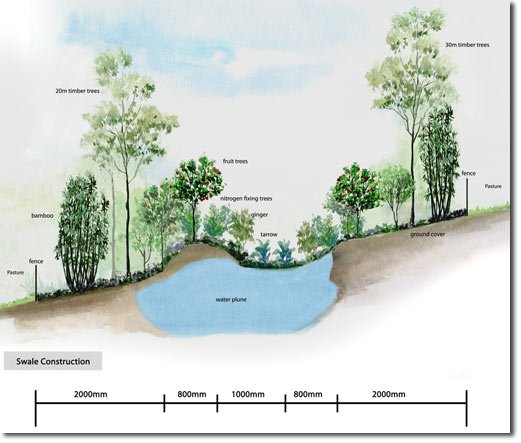
Click for larger view
Tree and planting methodology. Climate specific plant lists detailed how these systems work within the swale system. Trees species were covered, like bamboos, timber plantations, pioneer species, wetland marginal plants, fruit trees, and finally details on growing their own trees, since they have more than 17,560 estimated trees to plant over the next 20 years and also an idea to make use of the remarkable system of Mr Peter Lawton (no direct relation to Geoff) with the Rocket Rack and pot system as a way of growing their own trees and selling some to subsidise the planting costs.
Pasture management is a very important part of the project. Mariette gave very detailed and concise information regarding the horses’ health and the quality of the pasture.
The final part of the document went into all the associated elements of: black/grey water systems, alternative energy systems, water harvesting for human consumption and finally aquaculture in farm dams.
The conclusion (unlike this one) was brief and concise with a directive to act and where to start and some achievable outcomes for the years ahead.
The level of detail in a project will depend on the client’s desire, and the depth of their pockets. I’m just starting a project in Gippsland, Victoria where the client said they didn’t want a detailed report and just a simple plan would do. And that will work fine for them on their 3000 acre farm, because they have engaged me to implement it over the next six years. So at each stage, I’ll quote and specify the works according to the concept and then we go from there.
My advice to keen designers would be to start small — like on your own block and/or family land — and start putting together a design. Start testing your ideas, and get another permaculture designer to test it and see where its strong and weak points are.
If you want to get into the world of permaculture design, construction and even maintenance, start looking at reverse engineering a project that you know of. How much will that retaining wall cost? How long will it take to move 300m3 of earth with a 5 tonne excavator versus with a 20 tonne machine? Start pulling it apart one nut and bolt at a time.
Have fun with it. If you have any questions about starting a business, costing and estimating or anything design related, please send your details via the internal messaging system of the Worldwide Permaculture Network (if you’re a member of the network you’ll see a ‘Contact this user’ button on my profile) and we could Skype or phone so I can point you in the right direction.




















